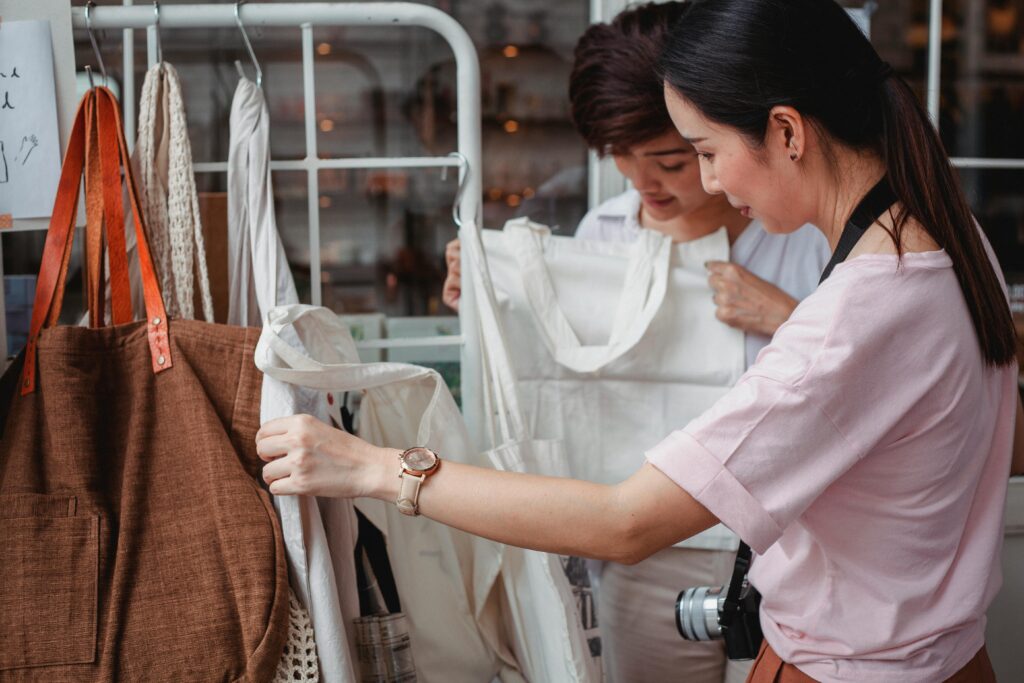As more people open their eyes to the mess fast fashion leaves behind, pollution, unfair labor, and mountains of waste, the demand for something better is exploding.
These days, shoppers don’t just want cute outfits. They want to know that their money is supporting brands that care about people and the planet.
If you’re someone who’s passionate about making a difference and has a little entrepreneurial fire in your belly, starting an online sustainable fashion store isn’t just a cool idea.

It’s a chance to be part of real, lasting change.
And don’t worry, you don’t have to figure it all out alone. This guide is here to walk you through everything you need to know to launch a thriving, sustainable fashion online store.
First Things First: What Is Sustainable Fashion Really About?
Before you dive in, it’s important to get super clear on what sustainable fashion means, beyond the hype.
It’s not just about selling eco-friendly tees or putting “green” on your website. It’s about thinking through every step.
This is from how your fabrics are made, to who’s sewing your clothes, to what happens to your pieces when your customers are done wearing them.
Here’s what truly sustainable fashion stands for:
1. Ethical Production Practices
Sustainability isn’t just about the planet, it’s about human beings too. It means making sure:
- Workers are paid fairly and treated with respect
- Factories are safe and healthy places to work
- No child labor, no forced labor, period
- Workers have rights and a real voice
Many brands make this happen by partnering with ethical manufacturers or by working directly with artisan communities around the world.
When you care about the people making your clothes, it shows, and your customers will feel it too.
2. Reducing Environmental Impact
To be honest, fashion is one of the most polluting industries out there. But sustainable brands do the hard work to change that. They:
- Save water and energy wherever they can
- Cut down on carbon emissions
- Say no to toxic dyes and harmful chemicals
- Recycle and manage waste smartly
It’s all about leaving the planet better than we found it, or at the very least, doing a lot less damage.
3. Choosing Materials That Matter
If you want to create fashion that feels good and does good, it starts with what you make it from. The best sustainable brands are picky about materials, going for things like:
Organic cotton, hemp, linen, plants that don’t guzzle chemicals and water
Recycled fabrics (hello, plastic bottles turned into buttery-soft leggings)
Upcycled old fabrics that get a second chance at life
New, exciting options like TENCEL™ (from eucalyptus trees!), Piñatex (made from pineapple leaves), and even mushroom leather (seriously)
Better materials = a smaller footprint and a fresher, more interesting brand.
4. Durability and Longevity
Fast fashion teaches us to buy cheap, wear once, and toss.
Sustainable fashion? It’s the total opposite. It’s about:
Designing clothes that can be worn again and again (and still look amazing)
Creating timeless styles that don’t go out with the next trend
Offering repairs, resale, and other programs to keep clothes out of landfills
The goal isn’t to sell more, it’s to sell better. When you help people buy smarter, they’ll stick with your brand for the long haul.
5. Keeping It Real with Radical Transparency
Today’s shoppers are savvy. They can smell fake from a mile away. They want to know:
Where are their clothes coming from
Who’s making them
What kind of impact are their choices having
That means you need to be crystal-clear about your supply chain, show off your certifications when you have them, and always keep it real in your marketing.
No greenwashing. No half-truths. Just honesty, even if you’re still a work in progress. (Spoiler: everyone is.)
Bottom line: if you build your brand around these real, grounded values, you won’t just be “getting in” on a trend, you’ll be part of the movement making fashion better for everyone.
Why Launch a Thriving Sustainable Fashion Online Store
Okay, so here’s the thing: fashion is changing. People are waking up.
They’re realizing that what we wear matters. Not just in terms of style, but how it’s made, who made it, and what kind of impact it has on the planet.
If you’re thinking about starting a sustainable fashion store online, honestly? You’re onto something special.
▪️Meet the Demand for Ethical Choices
As we know, shoppers aren’t just buying for the look anymore, they want to feel good about their choices.
When you offer pieces that are made with care, for the earth and the people who made them, you’re giving them something to connect with.
That kind of connection? It’s everything.
▪️Differentiate Your Brand.
In a sea of fast fashion, being sustainable is like saying, “Hey, we can do better.” And people love that.
It makes your brand more than a store, it makes it a movement. Something with heart.
▪️Long-Term Profitability
Will it take some extra thought and effort? Yeah. But the kind of loyalty and love you build? That lasts. Customers stick around when they know you care.
▪️Positive Social and Environmental Impact
Less waste. Fairer work. Smarter choices. Every little decision you make adds up to something bigger. And that ripple effect? That’s where the real magic is.
▪️Flexibility and Reach of E-commerce
No rent, no storefront stress, just you, your vision, and the freedom to grow on your terms.
You can reach people all over the world from your laptop. That’s wild.
At the end of the day, this isn’t just about fashion. It’s about doing things differently. Creating something honest. Something with soul.
And if you’re feeling that pull, you’re 100% on the right path.
The Ultimate Guide to Building a Thriving and Ethical Online Fashion Business
Fashion isn’t just about looking good anymore, it’s about doing good, too. People are waking up.
They want to know where their clothes come from, who made them, and what they stand for.
And if you’re dreaming of launching a sustainable fashion brand, that means you’ve got heart.
But let’s be real: building a business that’s both ethical and successful online? It’s not easy, but it is doable. Especially when you have a clear path and a strong purpose.
Here’s a guide to help you build a fashion brand that matters.
1. Understanding of the Sustainable Fashion Ecosystem
Before you dive in, take a beat to learn about the world you’re joining.
Sustainable fashion isn’t just about eco fabrics, it’s about people, planet, and culture all at once.
Things worth digging into:
Next-gen materials: Stuff like Piñatex (yep, pineapple leather), mushroom-based Mylo, seaweed fabrics, it’s all real, and it’s all cool.
🔁 Circularity: Think take-back programs, clothing repairs, rentals, and upcycling. It’s all about keeping clothes in use, not landfills.
✊ Labor rights: Look into the actual conditions in places where clothes are made, like Bangladesh or Ethiopia. This matters big time.
▪️ How shoppers are changing: People are leaning toward capsule wardrobes, secondhand shopping, and saying “nah” to fast fashion.
▪️ Do this now: Write down what sustainability means to you and your brand. Be honest, be specific. This becomes your north star.
2. Define Brand Identity
This is where a lot of brands get it twisted: your brand isn’t your colors or your font. It’s your why. It’s how people feel when they hear your name.
What to figure out:
▪️ Your Mission: What are you fighting for or standing up for? Waste? Worker rights? Culture? Climate?
💚 Your Values: Pick 3–5 that will guide everything you do. Think: honesty, equity, community, minimalism.
🧍 Your People: Who’s your ideal customer? Not just age or gender—what do they care about? What inspires them?
▪️ Your Look & Voice: Your visuals and tone should feel intentional, warm, and rooted in the lifestyle you’re promoting.
⚠️ Real talk: If you’re all branding and no purpose, people will sniff that out. Authenticity always wins.
3. Develop a Transparent, Ethical, and Sustainable Supply Chain
Behind every item you sell is a whole chain of people, resources, and decisions.
Make sure that the chain is as thoughtful and ethical as your brand claims to be.
How to get started:
▪️ Use better materials: Organic cotton, certified fabrics, natural dyes, recycled blends—look for legit certifications like GOTS or OEKO-TEX.
▪️ Choose ethical partners: Visit your factories (or FaceTime them). Talk to your makers. Build real relationships.
▪️ Make only what you need: Go for small batches or made-to-order to reduce waste.
📦 Sustainable packaging: Think compostable mailers, plastic-free tags, reusable bags. Every detail counts.

🗺️ Bonus idea: Add a page on your site showing where everything comes from and who’s behind each piece. People love transparency.
4. Build an E-Commerce Website
Your online store should feel like your brand’s home. Not just a place to buy stuff, but a place to connect, learn, and get inspired.
Make sure your site has:
▪️ Clean, sustainable design: Keep it fast, light, and low on unnecessary animations (less digital pollution!).
📖 Product storytelling: Don’t just say “100% organic cotton tee.” Tell me who made it, why it’s special, and how to take care of it.
▪️ Accessibility: Everyone should be able to use your site. Alt text, readable fonts, and screen-reader friendly.
🌎 Impact metrics: Show off how much waste you’ve diverted or how many liters of water you’ve saved. It builds trust.
🧰 Pro tip: Shopify is great if you want to scale, Webflow’s perfect if design’s your thing, and WooCommerce gives you full control.
5. Create Content That Educates and Inspires
Sustainably, content isn’t just about selling, it’s about teaching and connecting.
People want to know more, and you get to be their guide.
Ways to bring your message to life:
✍️ Write helpful blogs: How to care for your clothes, why fast fashion is harmful, what “ethical” really means.
🎥 Make real videos: Show how something’s made. Interview your makers. Walk through your process.
▪️ Interactive stuff: Quizzes, wardrobe calculators, style guides—people love to play and learn.
🗣️ Join the conversation: Talk about climate, feminism, culture, and craft. Position your brand as part of something bigger.
🔎 SEO tip: Use niche keywords that your people are searching for. Stuff like “affordable ethical loungewear” or “eco-friendly hijabs.”
6. Market with Purpose, Not Just Promotion
Sustainable fashion marketing isn’t about “Buy Now!” It’s about building a community, telling stories, and showing people they’re part of something meaningful.
Try this:
💬 Start real conversations: Ask questions. Share values. Get your community involved.
🤝 Work with aligned influencers: Look for micro-influencers who live the slow fashion life, not just pose for it.
▪️ Collaborate with causes: Team up with nonprofits or mutual aid groups that reflect your mission.
💌 Send emails with heart: Welcome sequences, behind-the-scenes stories, garment care tips, post-purchase follow-ups.
📱 Hot tip: Use short videos on TikTok or Reels to explain things simply and visually, like how your shirt helps save water, or how to spot greenwashing.
7. Keep Checking In and Growing
Sustainability isn’t a box you tick once, it’s a journey. And it’s okay not to be perfect.
What matters is that you stay curious, transparent, and willing to improve.
Things to track:
🔍 Impact per item: How much water or energy went into this? What happens at the end of its life?
💌 Customer feedback: What do people love? What could be better? Don’t be afraid to ask.
📊 Sustainability reports: Share your wins and your goals. Even if you’re small, it shows you care and builds trust.
📦 Helpful tools to explore:
EcoCart – lets customers offset their purchase
Shopify Planet – climate-focused features
Klarna Conscious – for visibility in ethical shopping
Google Analytics + Hotjar – to see how people use your site
Conclusion.
You’re not just building a fashion brand, you’re creating something that matters.
Something with a heartbeat. Something that can shift how people think, buy, and care.
And sure, it takes work. But the impact? It’s worth it.
Because in a world full of throwaway trends, you have the chance to build something timeless. Not just clothes. Not just content. But culture.
This isn’t just a business. It’s a movement. And you? You’re the one starting it.

